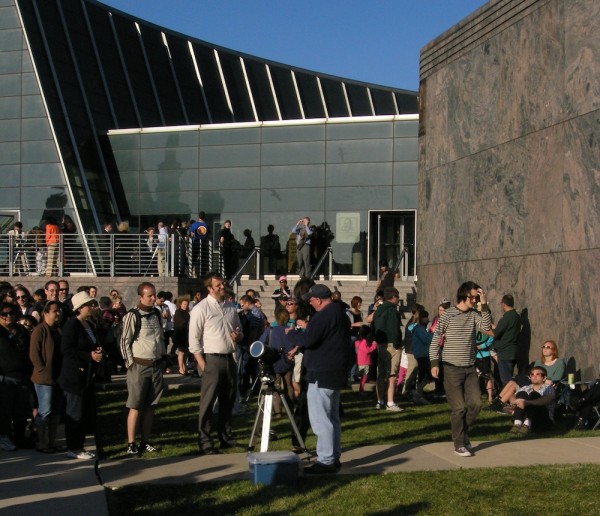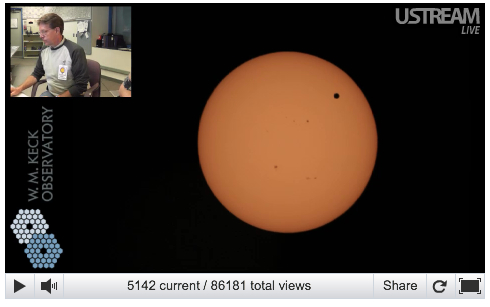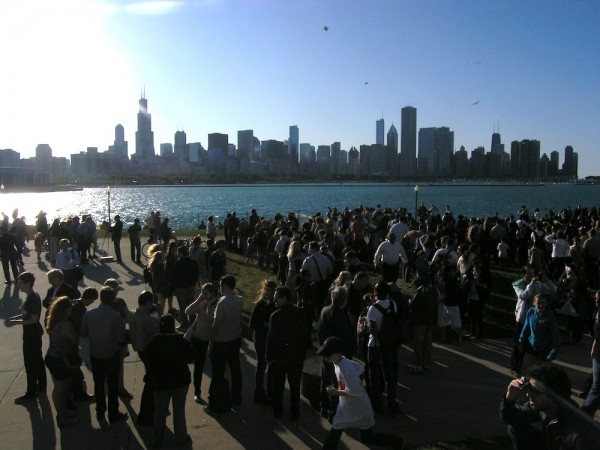![]() On Tuesday afternoon, I took the bus to downtown Chicago and walked out to the prime piece of lakeshore real estate that is occupied by the Adler Planetarium. This was hardly the epic journey that some of my British forebears undertook to see Venus transit across the Sun, but I was still keen to personally observe the event through a telescope. As it turned out, I wasn’t the only one to have this idea:
On Tuesday afternoon, I took the bus to downtown Chicago and walked out to the prime piece of lakeshore real estate that is occupied by the Adler Planetarium. This was hardly the epic journey that some of my British forebears undertook to see Venus transit across the Sun, but I was still keen to personally observe the event through a telescope. As it turned out, I wasn’t the only one to have this idea:

Queuing to observe the Venus Transit at the Adler Planetarium, 5 June 2012. Photo: Chris Rowan 2012.
After a wander through the planetarium itself, I joined the queues outside and eventually got my 20 seconds of peering through an eyepiece at the sun, seeing both the black dot of Venus itself and an impressive constellation of sunspots. Mission accomplished, and not just for me: the Adler itself had done more than stick a few telescopes on its lawn, with lots of other scientific and historical information on display, and incorporated into their planetarium shows. One of the coolest things that I learnt was that observations being taken during this transit will help us to characterise the atmospheres of exoplanets as they transit their parent stars (which is how the likes of Kepler actually spot them in the first place); because we know the composition of Venus’ atmosphere very well, it provides a useful calibration point (as this article explains). All this was clearly a pretty successful exercise in scientific outreach: lots of people turned up to see the transit, and the atmosphere was one of excitement and fascination.
The sun set behind the skyscrapers of downtown Chicago long before the transit was over, so I headed back home, fired up my web browser and pointed it to NASA’s livestream from the Keck Observatory on Hawaii. As the screen capture below shows, I joined more than 86,000 people in doing so – possibly many more before the transit was over – and whilst it may have lacked the more visceral experience I got from actually peering through a telescope lens, it more than made up for this by there being no queue of people behind me waiting to take their turn and pressuring me to cut short my ogling. Clearly, with lots of viewers and lots of interaction the astronomers providing commentary on the livestream, who were having a great time answering a never-ending stream of questions, NASA’s online streaming was another outreach success.

The NASA livestream of the Venus transit from the Keck Observatory
But the transit experience didn’t end there: in the last couple of days, I’ve continued to be supplied with stunning imagery via blogs and Twitter. I think my favorite was this video of the first moments of the transit, where Venus’ atmosphere is clearly lit up by the sun’s glow before it fully entered the suns disc.
The penumbra of tweets, blogs and videos around this event clearly augmented the experience for many people. Before the transit, it told people it was happening and why it was important and rare, and told them where they could go to observe it; during and after the transit it was the means of sharing a constant stream of gorgeous pictures and videos (particularly from NASA’s various outlets). Not only was all this activity successful scientific outreach in itself, but by widely promoting the other events I’ve been talking about, it undoubtedly boosted their own success.
In a week when the question of why scientists in academia don’t do more outreach, and how hard it is to get professional credit if we try (see some excellent posts from SciCurious, Kate Clancy, and Cedar Riener), has once more reared its head, I think this last point is worth pondering. Of course, outreach is a much more prominent part of the remit of organisations like NASA and the Adler planetarium, which means that some of the pressures that inhibit scientists who work at research universities are less stifling. But this use of blogs and social media to augment more approved forms of outreach might help to convince our still-skeptical peers and superiors that all this internet stuff is not a complete waste of our time. This doesn’t always have to be the case, of course, but the prospect of adding value to forms of outreach that are more accepted – things like open days and public lectures – might be a helpful lever.




Nice plan for content warnings on Mastodon and the Fediverse. Now you need a Mastodon/Fediverse button on this blog.